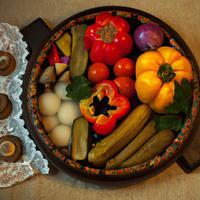
1 serving (150 grams) contains 80 calories, 2.0 grams of protein, 3.0 grams of fat, and 10.0 grams of carbohydrates.

Log this food in SnapCalorie

Nutrition Information
Calories |
126.2 | ||
|---|---|---|---|
% Daily Value* |
|||
| Total Fat | 4.7 g | 6% | |
| Saturated Fat | 0.8 g | 4% | |
| Polyunsaturated Fat | 0 g | ||
| Cholesterol | 0 mg | 0% | |
| Sodium | 315.5 mg | 13% | |
| Total Carbohydrates | 15.8 g | 5% | |
| Dietary Fiber | 4.7 g | 16% | |
| Sugars | 6.3 g | ||
| protein | 3.2 g | 6% | |
| Vitamin D | 0 mcg | 0% | |
| Calcium | 63.1 mg | 4% | |
| Iron | 1.6 mg | 8% | |
| Potassium | 473.2 mg | 10% | |
* Percent Daily Values are based on a 2,000 calorie diet. Your daily values may be higher or lower depending on your calorie needs.
Food Attributes
Source of Calories
About Vegetable side dishes
Vegetable side dishes are versatile, nutrient-packed options that complement any meal. Often featuring fresh ingredients like greens, root vegetables, or legumes, they can be steamed, roasted, grilled, or sautéed to enhance flavor. Popular in cuisines worldwide, dishes like Italian ratatouille, Asian stir-fried veggies, and American roasted squash offer unique regional twists. They are rich in vitamins, minerals, fiber, and antioxidants, promoting digestion, heart health, and overall vitality. Preparation methods such as steaming or roasting help preserve nutrients and reduce added fats. However, the healthiness of a vegetable side dish can be impacted by excessive use of oils, butter, or creamy sauces, increasing calorie and fat content. By using herbs, spices, and smart cooking techniques, vegetable sides become not only delicious but nutritionally beneficial additions to any plate, showcasing the natural vibrancy and health-boosting properties of plants.



